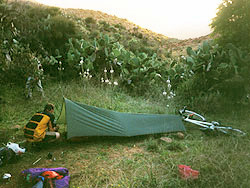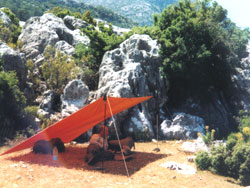 Surprisingly, tarps can keep you as dry as a tent, even through persistently wet weather, due to the superior ventilation. Unlike a tent, if is safe to cook under a tarp because of the impossibility of fumes building up and the ease of exit should there be a mishap. Again good ventilation of a tarp means that cooking moisture does not end up running down the walls.
Surprisingly, tarps can keep you as dry as a tent, even through persistently wet weather, due to the superior ventilation. Unlike a tent, if is safe to cook under a tarp because of the impossibility of fumes building up and the ease of exit should there be a mishap. Again good ventilation of a tarp means that cooking moisture does not end up running down the walls.
How to Pitch a Tarp
There are many ways of pitching your tarp depending on the weather conditions and your objective, ie are you just taking a short break from the rain or sun, or setting up camp for the night or longer. Here are some basic suggestions:
- between two trees
- between two trekking poles
- between a tree and a hiking pole
- using an upturned bike as an anchor
- using found sticks as poles – if only thin or short ones are available, try lashing them together
- as a lean-to using two trees or sticks or poles [in wet weather it is worth rem bering that any configuration without a ridge is more likely to hold rain]
- The base of bushes can serve as good anchor points for guys as can tree roots and rocks, particularly flat ones that tend to be more stable under tension.
After pitching the tarp spend a minute under it removing any stones and thorns. Leave anything like leaves and pine needles in place to act as insulation and additional mattress. Heather and thick grass make good padding.
Consider the Weather
When a storm develops and increase in wind speed has an exponential increase in force and stress on the fixed shape and surfaces of a tent, whereas a tarp can be lowered and flattened to reduce forces on it.
In fine weather, pitch your tarp high off the ground for that feeling of really being ‘out there.’
In wet and windy weather
Pitch sideways on to the wind and wide and low with the windward side pegged down on the ground. In storms, rocks, logs, earth or sand can be added to the sides if necessary.
Remember a small breeze lowing through is beneficial as it removes the large amount of moisture given off by your body.

Where to Pitch a Tarp
Generally the old maxim ‘climb high then camp low’ remains true. The valley bottoms, which often contain the authorised camp sites, will get the coldest during the night because of falling cold air collecting there. The peaks and ridges on the other hand are prone to sudden forceful wind and storms so are best avoided unless that is what you are seeking. Somewhere between the two, possibly with some shelter from rocks or trees makes the best choice.
Avoid dished and compacted ground as rain will pool in depressed area and flood them if it cannot drain off. Again many authorised camp sites are dished and compacted by years of use, by people and their vehicles. Camping under dead trees or any branches which look like they could break off under a weight or rain, or a storm is probably not a good idea.
